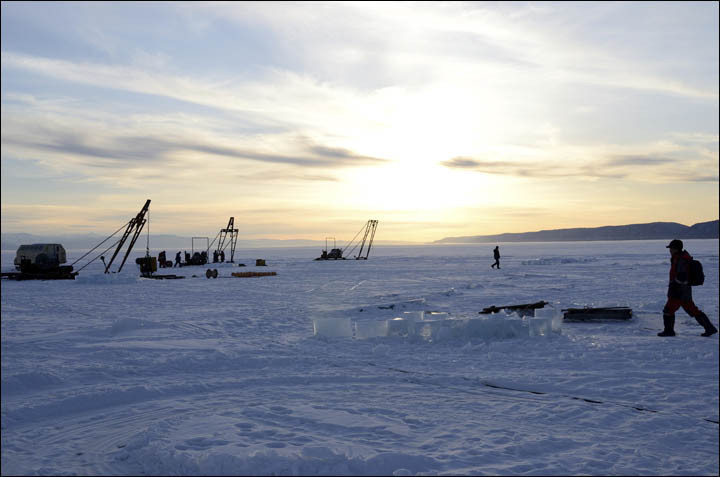Neutrino: Russian, Chinese and Indian experiments in quest for elusive material

Russian, Chinese and Indian scientists are in various stages of setting up devices to detect one of the universe's most abundant, yet almost invisible particles -- the neutrinos.
The Russians plan to catch the elusive neutrinos in the act with a high-tech telescope placed under the ice at Lake Baikal in Siberia.
Located 1.3km under the surface, the Dubna telescope will use 192 optical modules to record the "invisible" neutrinos as they interact with water to generate a glow from the cascade of charged particles generated.
The glow called Cherenkov's Light will help trace the ubiquitous, non-interacting, light matter that was generated during the Big Bang and continues to be created in the many explosive events of the cosmos.
Valery Rubakov, head of the Section of Nuclear Physics, of the Physical Sciences Division of the Russian Academy of Science, told the Siberian Times: "The neutrino is so unique because it is a carrier of information about the processes occurring in the universe, and its interaction with matter is very weak. The natural flow of the neutrino carries rich and unique information about the world around us.
"The study of this flow can give a key to understanding the early stages of the evolution of the universe, the processes of the formation of the chemical elements, the mechanism of evolution of massive stars and supernova explosions, and shed light on the problem of the dark matter, as well as the composition and internal structure of the Sun today and in a fairly remote past.
"It can also give us an even deeper insight into the problem of the internal structure of one of the most difficult to study objects - planet Earth."
Similar powerful telescopes already exist in the Antarctica (IceCube) and in the Mediterranean but the Russian telescope is claimed to be very sensitive.

Eco hurdles
India's ambitious neutrino observatory planned in the southern state of Tamil Nadu continues to face hurdles since conceptualisation years ago.
The latest is a writ filed in court by environmentalists alleging the site is in a seismic and highly biodiverse area and that tunnelling could affect nearby aquifers.
In March this year, the Madras High Court Bench deferred its decision without mentioning a date.
The India-based Neutrino Observatory (INO) in Bodi West Hills, Tamil Nadu, received Cabinet approval early this year at an estimated cost of Rs 15bn (£1.5 bn).
The INO is to be built around 1.3 km beneath the hills which provide a granite cover that blocks most other particles other than the neutrino.
The 2 km-long tunnel with three caverns will house the 50,000-tonne iron calorimeter neutrino detector.
A study carried out by the Geological Survey of India (GSI) last year concluded that there was no major threat of groundwater getting into the access tunnel or caverns.
"The site is a wasteland, a barren land," INO project director Naba Mondal of the Tata Institute of Fundamental Research in Mumbai told media.
Pottipuram was selected after environmentalists protested the original choice which was near an elephant corridor.
Unlike most neutrino detectors, the INO will be sensitive to both neutrinos and anti-neutrinos, and will eventually be used to detect neutrinos beamed from Cern or Fermilab to study how neutrinos oscillate from one type to another as they pass through the Earth.
Unusual events
Indian scientists had in the 60s pioneered earlier neutrino experiments at an underground laboratory at Kolar Gold Fields in Karnataka.
In a global first, the detector inside the 2,316-metre-deep gold mine recorded a series of unusual events in 1965 which were attributed to atmospheric neutrinos.
The eight events detected in around a decade were, however, much higher than standard processes associated with neutrinos, expected to yield an event in a century.
It was interpreted to be the decay of a massive unknown particle, which eluded detection at Cern or Fermilab in later years.
Indian scientists are now suggesting the events could have been the result of decaying dark matter, a concept not yet popular in the 60s.
China project
China is also involved in the construction of a neutrino observatory in Jiangmen with similar goals as the INO. The observatory is expected to be completed by 2020.
In the US, the Department of Energy's Fermi National Accelerator Laboratory outside Chicago conducts neutrino experiments while in Japan, the Super-Kamiokande and in Canada the Sudbury observatory keeps a watch for the hard-to-catch abundant material.
The reticent neutrino is detected only by the energy generated during very occasional interactions. Being chargeless, it is not affected by electromagnetic fields and interacts via gravity.
Some scientists believe that most of the neutrinos have their source in the Big Bang but most of these ancient neutrinos would be left with very little energy after 14 billion years.
The European Space Agency's Planck satellite data has in fact picked up neutrinos released a second after the Big Bang using their interactions with the relic background microwave radiation.
Mystery particles
Calculations suggest there must be around 40 billion of the "invisible" neutrinos in a cubic centimetre of the atmosphere.
Neutrinos come in three types or flavour - electron-neutrino, muon-neutrino and tau-neutrino. They oscillate among the three.
Each neutrino flavour has a slightly different mass, although physicists do not yet know exactly what those masses are. Of the three neutrino flavours, the heaviest has at least one 10 millionth the electron's mass.
The mass differences among flavours are believed to be the main factor affecting how neutrinos oscillate or morph as they pass through space, people, matter and Earth. This morphing is what experiments hope to observe and understand.
© Copyright IBTimes 2025. All rights reserved.





















